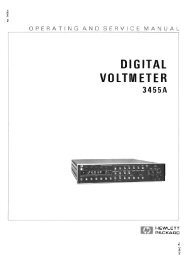tm 11-6625-2495-14&p technical manual operator's - F6FZK - Free
tm 11-6625-2495-14&p technical manual operator's - F6FZK - Free
tm 11-6625-2495-14&p technical manual operator's - F6FZK - Free
Create successful ePaper yourself
Turn your PDF publications into a flip-book with our unique Google optimized e-Paper software.
D-1. General<br />
This appendix provides a summary of the maintenance<br />
operations for SG-747/U. It authorizes categories of<br />
maintenance for specific maintenance functions on<br />
repairable items and components an the tools and<br />
equipment required to perform each function. This<br />
appendix may be used as an aid in planning<br />
maintenance operations.<br />
D-2. Maintenance Function.<br />
Maintenance functions will be limited to and define as<br />
follows:<br />
a. Inspect. To determine the serviceability of a<br />
item by comparing its physical, mechanical, and/or<br />
electrical characteristics with established standard<br />
through examination.<br />
b. Test. To verify serviceability and to detect<br />
incipient failure by measuring the mechanical or<br />
electrical characteristics of an item and comparing those<br />
characteristics with prescribed standards.<br />
c. Service. Operations required periodically to<br />
keep an item in proper operating condition, i.e., to clean<br />
(decontaminate), to preserve, to drain, to paint, or to<br />
replenish fuel, lubricants, hydraulic fluids, or compressed<br />
air supplies.<br />
d. Adjust. To maintain, within prescribed limits by<br />
bringing into proper or exact position, or by setting the<br />
operating characteristics to the specified parameters.<br />
e. Align. To adjust specified variable elements of<br />
an item to bring about optimum or desired performance.<br />
f. Calibrate. To determine and cause correction to<br />
be made or to be adjusted on instruments or test<br />
measuring and diagnostic equipments used in precision<br />
measurement. Consists of comparisons of two<br />
instruments, one of which is a certified standard of<br />
known accuracy, to detect and adjust any discrepancy in<br />
the accuracy of the instrument being compared.<br />
g. Install. The act of emplacing, seating, or fixing<br />
into position an item, part, module (component or<br />
assembly) in a manner to allow the proper functioning of<br />
the equipment or system.<br />
APPENDIX D<br />
MAINTENANCE ALLOCATION<br />
SECTION I. INTRODUCTION<br />
D-1<br />
TM <strong>11</strong>-<strong>6625</strong>-<strong>2495</strong>-14&P<br />
h. Replace. The act of substituting a serviceable<br />
like type part, subassembly, or module (component or<br />
assembly) for an unserviceable counterpart.<br />
i. Repair. The application of maintenance services<br />
(inspect, test, service, adjust, align, calibrate, replace) or<br />
other maintenance actions (welding, grinding, riveting,<br />
straightening, facing, remachining, or resurfacing) to<br />
restore serviceability to an item by correcting specific<br />
damage, fault, malfunction, or failure in a part,<br />
subassembly, module (component or assembly), end<br />
item, or system.<br />
j. Overhaul. That maintenance effort<br />
(service/action) necessary to restore an item to a<br />
completely serviceable/operational condition as<br />
prescribed by maintenance standards (i.e., DMWR) in<br />
appropriate <strong>technical</strong> publications. Overhaul is normally<br />
the highest degree of maintenance performed by the<br />
Army. Overhaul does not normally return an item to like<br />
new condition.<br />
k. Rebuild. Consists of those services/actions<br />
necessary for the restoration of unserviceable equipment<br />
to a like new condition in accordance with original<br />
manufacturing standards. Rebuild is the highest degree<br />
of materiel maintenance applied to Army equipment.<br />
The rebuild operation Includes the act of returning to<br />
zero those age measurements (hours, miles, etc.)<br />
considered in classifying Army equipments/components.<br />
D-3. Column Entries.<br />
a. Column 1, Group Number. Column 1 lists group<br />
numbers, the purpose of which is to identify components,<br />
assemblies, subassemblies, and modules with the next<br />
higher assembly.<br />
b. Column 2, Component/Assembly. Column 2<br />
contains the noun names of components, assemblies,<br />
subassemblies, and modules for which maintenance is<br />
authorized.<br />
c. Column 3, Maintenance Functions. Column 3<br />
lists the functions to be performed on the item listed in<br />
column 2. When items are listed without maintenance<br />
functions, it is solely for purpose of having the group<br />
numbers in the MAC and RPSTL coincide.<br />
d. Column 4, Maintenance Category. Column 4



